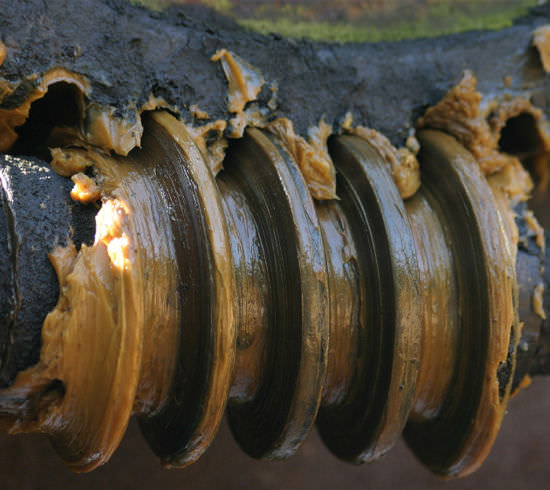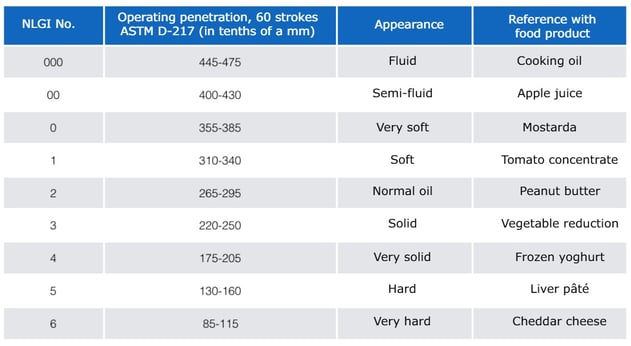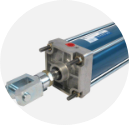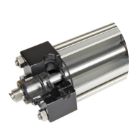
Mechanical engineers commonly seek out adhesiveness as a characteristic of lubricating grease. For this reason, greases are preferred to oils especially where it is necessary to hold the lubricant in place under high dynamic stress.
Indeed, a very adhesive lubricant makes it possible to limit typical centrifugal losses â as is the case with geared motors, for example. Yet, excessive adhesiveness can be counter-productive and act as a brake on kinematic motion, which is why it is necessary to balance the main constituents (base oil, thickener and additives) in order to prevent:
It is possible to objectively measure the adhesiveness of a lubricating grease through the identification of:
The main formulation parameters that can influence the adhesiveness of a lubricating grease are:
Base oil is the main ingredient of a lubricating grease, present in percentages never lower than 60â70% by weight, with viscosity measured in cSt or cPs identifying its internal friction. Base oils are conventionally divided into size groups through the ISO VG classification, which assigns each lubricating oil a nominal category whose details are:
The tolerance range of a viscosity measured at 40° C from the assigned nominal value is +/-10%. Thus, a polyalphaolefin oil of viscosity 35.50 cSt at 40° C will be assigned ISO category VG 32.
The viscosity of a base oil and its chemical composition both condition the adhesive power of the lubricating grease it will form, where the higher the viscosity, the higher its adhesiveness at a given temperature.
The elevated adhesive power of a lubricating grease formulated with an oil of 1500 cSt at 40° C will significantly reduce the loss of material by centrifugation but will produce an increase in friction and energy absorption, which is even more significant when operating at low temperatures. For this reason, the cohesive, filamentous and sticky action of the lubricating grease in use over a broad temperature range should be evaluated and characterised.
Once the correct viscosity of the base oil has been determined, depending on the thermal exposure of the mechanical component in its application context, two different parameters can be worked on:

Kinematics, linkages, mechanical actuators and uncovered gears often operate in direct contact with water, moisture or process fluids, where proper calibration of the adhesive power can reduce the loss of lubricant from friction zones through runoff.
Using a precision rotational rheometer, the adhesiveness of a lubricating grease can be measured and compared with other formulations.
Scopri di più

Scopri di più
Grasso lubrificante a base di polidimetilsilossano per cilindri a basso attrite risparmio energetico

Scopri di più
Grasso lubrificante a base sintetica per cilindri pneumatici con anelli di tenuta in EPDM

Scopri di più
Grasso lubrificante base PAO omologato per contatto accidentale con alimento

Maconsynth GT1/B
Grasso lubrificante a base di idrocarburo sintetico per cilindri pneumatici senza stelo

Pneugrease HTS
Grasso lubrificante a base di polidimetilsilossano per cilindri a basso attrite risparmio energetico

Maconsynth Retrac 400
Grasso lubrificante a base sintetica per cilindri pneumatici con anelli di tenuta in EPDM

Ultragrease ATOX 2
Grasso lubrificante base PAO omologato per contatto accidentale con alimento

HEAD OFFICE:
Macon Research Srl
Via Santa Lucia, 8/D
36056 Tezze sul Brenta (VI)
Tel.+39 0424.57.39.66
Fax.+39 0424.57.39.66
Mail: info@maconresearch.com
ADMINISTRATIVE OFFICE:
Macon Research Srl
Via L. Tolstoj, 43/O
20098 San Giuliano Milanese (MI)
Tel.+39 02.98.24.41.61
Fax.+39 02.98.24.4161
Mail : info@maconresearch.com
The data contained in this catalogue are based on our general experience and knowledge at the time of publication and are intended to provide the reader with technical information about any possible uses. This information does not, however, constitute an assurance as regards product characteristics in relation to specific cases. We recommend that you request an interview with our consultants. We would be happy to provide you with samples.